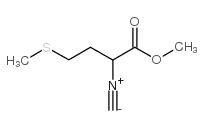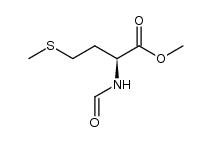2-isocyano-4-(methylthio)butyric acid methyl ester
Modify Date: 2025-09-11 11:28:40

2-isocyano-4-(methylthio)butyric acid methyl ester structure
|
Common Name | 2-isocyano-4-(methylthio)butyric acid methyl ester | ||
|---|---|---|---|---|
| CAS Number | 63472-90-2 | Molecular Weight | 173.23300 | |
| Density | 0.98 | Boiling Point | 104ºC (1.5002 mmHg) | |
| Molecular Formula | C7H11NO2S | Melting Point | N/A | |
| MSDS | N/A | Flash Point | N/A | |
| Name | 2-isocyano-4-(methylthio)butyric acid methyl ester |
|---|
| Density | 0.98 |
|---|---|
| Boiling Point | 104ºC (1.5002 mmHg) |
| Molecular Formula | C7H11NO2S |
| Molecular Weight | 173.23300 |
| Exact Mass | 173.05100 |
| PSA | 51.60000 |
| LogP | 0.43110 |
| Index of Refraction | 1.48-1.482 |
| InChIKey | SJNRQWGYTLWBBS-UHFFFAOYSA-N |
| SMILES | [C-]#[N+]C(CCSC)C(=O)OC |
| Storage condition | Refrigerator (+4°C) |
Synonym: Section 2 - COMPOSITION, INFORMATION ON INGREDIENTS
Risk Phrases: 20/21/22 36/37/38 Section 3 - HAZARDS IDENTIFICATION EMERGENCY OVERVIEW
Harmful by inhalation, in contact with skin and if swallowed. Irritating to eyes, respiratory system and skin. Potential Health Effects Eye: Causes eye irritation. Skin: Causes skin irritation. Harmful if absorbed through the skin. Ingestion: Harmful if swallowed. May cause irritation of the digestive tract. Inhalation: Harmful if inhaled. Causes respiratory tract irritation. Chronic: Not available. Section 4 - FIRST AID MEASURES Eyes: Flush eyes with plenty of water for at least 15 minutes, occasionally lifting the upper and lower eyelids. Get medical aid. Skin: Get medical aid. Flush skin with plenty of water for at least 15 minutes while removing contaminated clothing and shoes. Ingestion: Get medical aid. Wash mouth out with water. Inhalation: Remove from exposure and move to fresh air immediately. If not breathing, give artificial respiration. If breathing is difficult, give oxygen. Get medical aid. Notes to Physician: Treat symptomatically and supportively. Section 5 - FIRE FIGHTING MEASURES General Information: As in any fire, wear a self-contained breathing apparatus in pressure-demand, MSHA/NIOSH (approved or equivalent), and full protective gear. Will burn if involved in a fire. Extinguishing Media: Use water spray, dry chemical, carbon dioxide, or chemical foam. Section 6 - ACCIDENTAL RELEASE MEASURES General Information: Use proper personal protective equipment as indicated in Section 8. Spills/Leaks: Absorb spill with inert material (e.g. vermiculite, sand or earth), then place in suitable container. Section 7 - HANDLING and STORAGE Handling: Avoid breathing dust, vapor, mist, or gas. Avoid contact with skin and eyes. Storage: Store in a cool, dry place. Store in a tightly closed container. Section 8 - EXPOSURE CONTROLS, PERSONAL PROTECTION Engineering Controls: Facilities storing or utilizing this material should be equipped with an eyewash facility and a safety shower. Use adequate ventilation to keep airborne concentrations low. Exposure Limits CAS# 63472-90-2: Personal Protective Equipment Eyes: Not available. Skin: Wear appropriate protective gloves to prevent skin exposure. Clothing: Wear appropriate protective clothing to prevent skin exposure. Respirators: Follow the OSHA respirator regulations found in 29 CFR 1910.134 or European Standard EN 149. Use a NIOSH/MSHA or European Standard EN 149 approved respirator if exposure limits are exceeded or if irritation or other symptoms are experienced. Section 9 - PHYSICAL AND CHEMICAL PROPERTIES Physical State: Liquid Color: clear yellow Odor: stench pH: Not available. Vapor Pressure: Not available. Viscosity: Not available. Boiling Point: 104 deg C @2hPa Freezing/Melting Point: Not available. Autoignition Temperature: Not available. Flash Point: Not available. Explosion Limits, lower: Not available. Explosion Limits, upper: Not available. Decomposition Temperature: Solubility in water: Insoluble. Specific Gravity/Density: 0.980 Molecular Formula: C7H11NO2S Molecular Weight: 173.24 Section 10 - STABILITY AND REACTIVITY Chemical Stability: Not available. Conditions to Avoid: Incompatible materials. Incompatibilities with Other Materials: Strong oxidizing agents. Hazardous Decomposition Products: Carbon monoxide, oxides of nitrogen, oxides of sulfur, carbon dioxide. Hazardous Polymerization: Has not been reported Section 11 - TOXICOLOGICAL INFORMATION RTECS#: CAS# 63472-90-2 unlisted. LD50/LC50: Not available. Carcinogenicity: Methyl 2-isocyano-4-(methylthio)butyrate - Not listed by ACGIH, IARC, or NTP. Section 12 - ECOLOGICAL INFORMATION Section 13 - DISPOSAL CONSIDERATIONS Dispose of in a manner consistent with federal, state, and local regulations. Section 14 - TRANSPORT INFORMATION IATA Shipping Name: TOXIC LIQUID, ORGANIC, N.O.S.* Hazard Class: 6.1 UN Number: 2810 Packing Group: III IMO Shipping Name: TOXIC LIQUID, ORGANIC, N.O.S. Hazard Class: 6.1 UN Number: 2810 Packing Group: III RID/ADR Shipping Name: TOXIC LIQUID, ORGANIC, N.O.S. Hazard Class: 6.1 UN Number: 2810 Packing group: III Section 15 - REGULATORY INFORMATION European/International Regulations European Labeling in Accordance with EC Directives Hazard Symbols: XN Risk Phrases: R 20/21/22 Harmful by inhalation, in contact with skin and if swallowed. R 36/37/38 Irritating to eyes, respiratory system and skin. Safety Phrases: S 26 In case of contact with eyes, rinse immediately with plenty of water and seek medical advice. S 36/37/39 Wear suitable protective clothing, gloves and eye/face protection. WGK (Water Danger/Protection) CAS# 63472-90-2: No information available. Canada None of the chemicals in this product are listed on the DSL/NDSL list. CAS# 63472-90-2 is not listed on Canada's Ingredient Disclosure List. US FEDERAL TSCA CAS# 63472-90-2 is not listed on the TSCA inventory. It is for research and development use only. SECTION 16 - ADDITIONAL INFORMATION N/A |
| Hazard Codes | Xn |
|---|---|
| Risk Phrases | 36/37/38-20/21/22 |
| Safety Phrases | 36/37/39-26 |
| HS Code | 29309099 |
|
~81% 
2-isocyano-4-(m... CAS#:63472-90-2 |
| Literature: Carney, Daniel W.; Truong, Jonathan V.; Sello, Jason K. Journal of Organic Chemistry, 2011 , vol. 76, # 24 p. 10279 - 10285 |
|
~% 
2-isocyano-4-(m... CAS#:63472-90-2 |
| Literature: Hemantha, Hosahalli P.; Sureshbabu, Vommina V. Journal of Peptide Science, 2010 , vol. 16, # 11 p. 644 - 651 |

